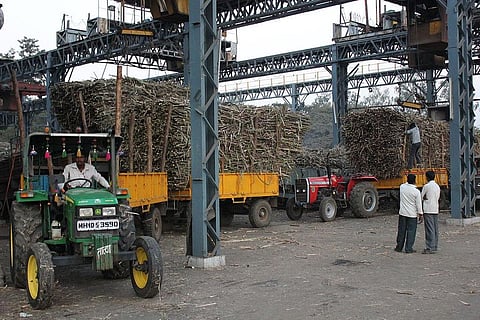
- Home
- न्यूजग्राम
- NewsGram USA
- India
- World
- Politics
- Entertainment
- Culture
- Lifestyle
- Economy
- Sports
- Sp. Coverage
- Misc.
- NewsGram Exclusive
- Jobs / Internships

Aurangabad, India, October 21, 2016: On the arrival of the very first nourishing monsoon showers in the drought-stricken zones of central India, farmers like Santosh Wagh hurried back to the plantations of sugarcane, the thirstiest crop; despite frequent appeals from the Indian government not to do so!
What makes the sugar cane plantation lucrative is its hardiness and the higher returns ensured by the state policies. These reasons lead the farmers to sow the crop despite the extreme water-demand of the cane relative to other crops. The plantation of sugarcane poses a threat to the usually arid zone and might plunge it back into drought, mentioned Reuters.
NewsGram brings to you latest new stories in India.
Wagh, 31, hails from Marathwada and plants 1.5 acres (0.6 hectares) of sugar cane and she says "It is the only reliable crop. Earlier this year I cultivated onions and incurred a 50,000 rupees loss as prices crashed."
According to Reuters, the largest sugar producing state in India, Maharashtra, suffered the most horrific drought 4 months ago as it damaged livestock devastating the crops and emptied reservoirs while slowing down the hydroelectric power output.
Sugarcane. Wikimedia
Compared to a commonly grown crop, chickpeas, consuming only 4 million litres of waters in its growing cycle; the cane consumes nearly 22.5 million litres and therefore the environmentalists and the government blamed the cane production for water scarcity.
According to Reuters, the increasing gap in income between the regular crop growers and the cane producers might lead to social unrest and the water scarcity will keep growing without the intervention of the government- warn experts.
Pradeep Purandare, a former professor at Maharashtra Water and Land Management Institute, said "The government asks farmers to shift to less water consuming crops, but it does little to support those crops. It failed to solve the problems of oilseed and pulses growers."
Go to NewsGram and check out news related to political current issues.
"Returns from other crops are unpredictable. This year it allowed 5 tonnes of onions to rot. Prices were so low that my losses would have increased by transporting onions to the market," said an Aurangabad farmer, Suresh Kothawale.
"We are creating oilseeds and pulses as an alternative for sugar cane by raising their minimum support prices," said a senior official at India's Agriculture Ministry who declined to be named.
But the industry critics claim that pulse and oilseed MSP exists on paper only.
In Marathwada the sugar mill build-up was primarily initiated by the politicians in order to gain prosperity in multiple areas of Maharashtra, focusing on regions with plentiful water.
"But later politicians opened mills everywhere, even in areas where drinking water is not available, to build a constituency rather than making farmers rich," said a political analyst, Jaidev Dole to Reuters.
Look for latest news from India in NewsGram.
Cane can withstand dry spells, heavy rainfall, diseases and less vulnerable to pests; and thus attracts farmers to sow it more. "I had taken crop insurance for pulses last year, but didn't get compensation despite losing an entire crop," said Sharad Mate, a farmer from Sillod, Aurangabad.
Indian government expects that a rise in subsidies for crops like oilseeds and common pulses will bring a change in the patterns of farming.
– prepared by Antara Kumar of NewsGram. Twitter: @ElaanaC
